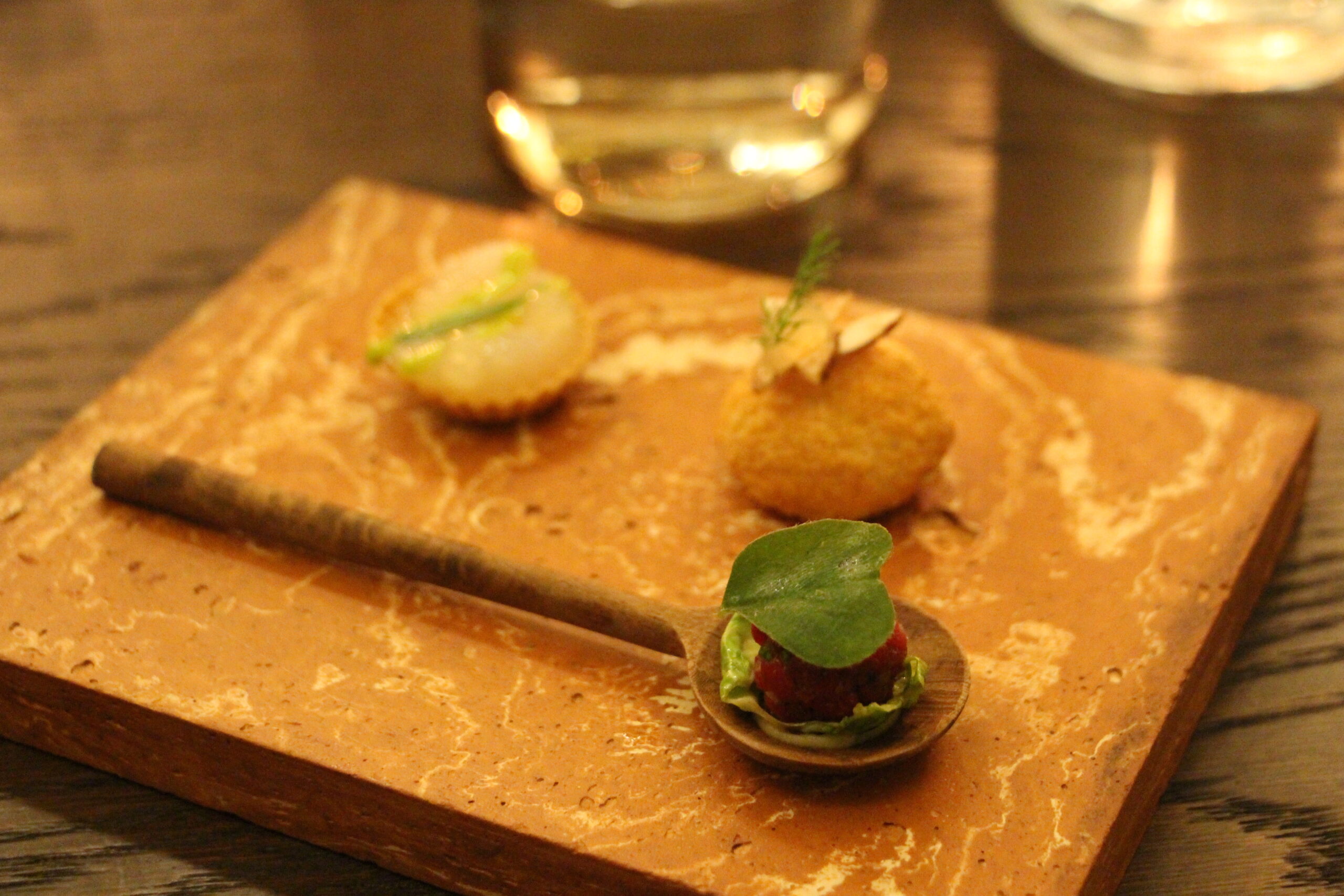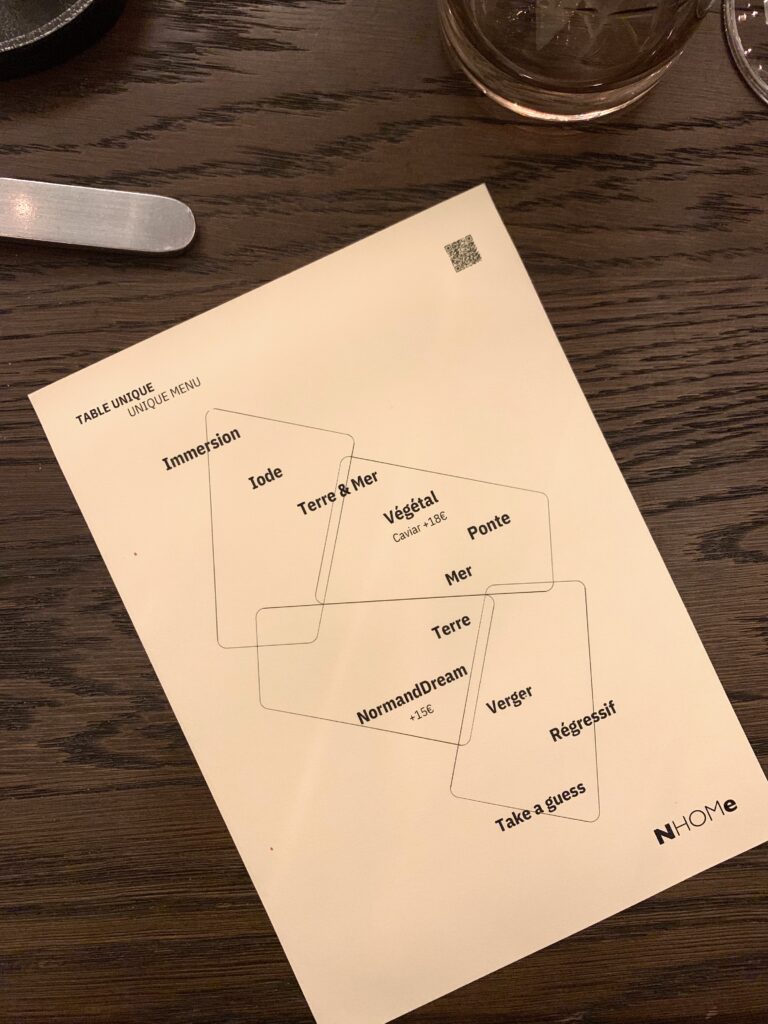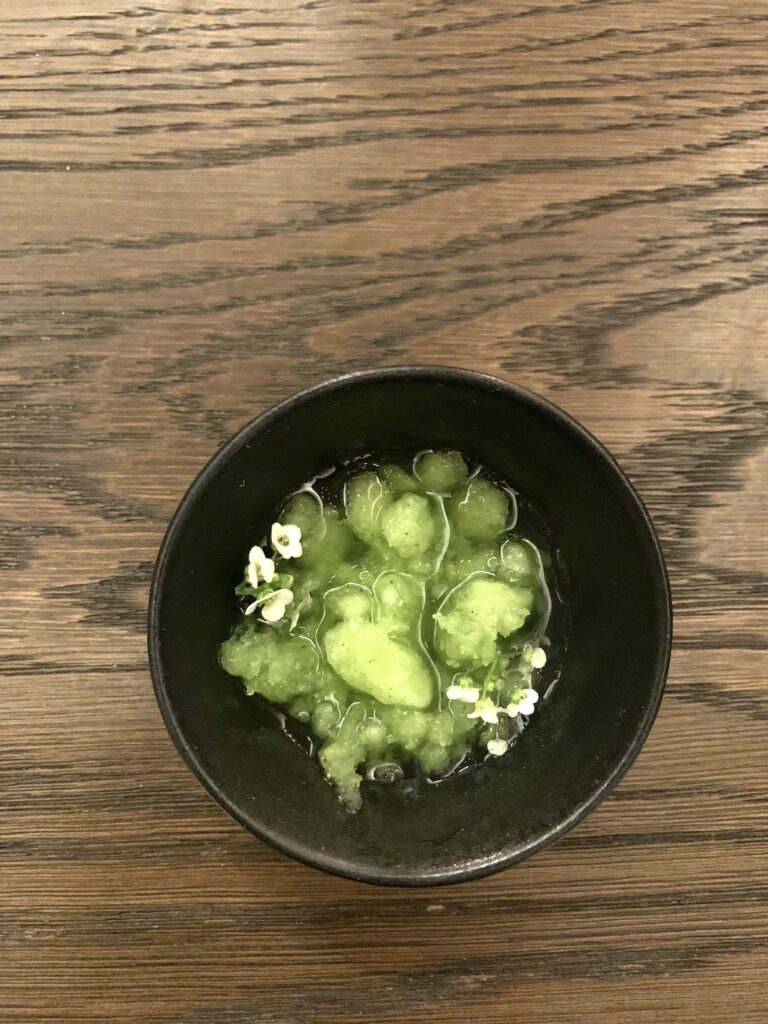Disclosure: I was a guest of the property for this meal.
In my line of work, I spend quite a bit of time thinking about the Venn diagram of the intellectually daring, challenging, daring cuisine that excites me to encounter and the sort of delicious, comforting fare I hope for when I head to someone’s home or to a classic bistro, diner, tavern, or trattoria. While the two categories tend often to be mutually exclusive, the sheer pleasure I get out of a place that balances both is bliss. And NHOMe is one of those places.
This fine dining spot steps from the Palais Royal is helmed by the French-Israeli Chef Matan Zaken. The convivial dining room is located in a beautiful vaulted cellar, where guests pull up a chair at a massive, 20-seat table that, on my visit in early January, was decorated with flickering candles and decorative gourds.
There’s a modernity to this space that’s only magnified by the young staff and chef, and yet it retains the refinement I look for in a fine dining locale. This is especially palpable seeing as I’ve seen the attention to ambiance been sidelined, of late, especially in spots helmed by younger chefs. The dining room at NHOMe, by contrast, is almost hallowed – a sensation only magnified by the lack of phone service in the cellar (don’t worry – if you’re wedded to connection, they do have WiFi). Personally, I kind of loved it, the way it forced me for three hours (yes, three hours) to focus exclusively on the food. And it deserves your full attention.
A nine-course tasting (140 euro) is the only option on offer. It’s a veritable voyage, with Chef Zaken plucking elements from cuisines near and far, reimagining them with an intricacy that earned him his first Michelin star in 2024.
An array of amuses set the scene, beginning with the simplest of the lot: a chou chaud, or hot cream puff, cheesy with a touch of truffle.
A miniature scallop tartlet was a touch more daring, with silky scallop settled into a buttery tartlet shell lined with bergamot mayonnaise. The interplay between the sweet, tender scallop and the crisp buttery pastry added loads of dimension to this bite.
But of the three, it was the mini tartare that blew me away. This little bite was seasoned with a deeply burnished scallion oil, which added new dimension to the beef without overpowering it or making it fatty. A touch of sumac lent welcome acidity, while Brussels sprout purée added depth and a nod to the season.
But if this amuse was so successful, it was because it truly set the scene for what was to come. At its most successful, NHOMe stands out by teasing out preconceived notions of French products and dishes, forcing the diner to interrogate their own biases and expectations.
There were, nevertheless, a few hiccoughs along the way, and I stumbled against one early on. The sumac and pomegranate certainly made this Finistère oyster pop on the plate, but the flavors got a bit lost in favor of the finger lime, which wasn’t as visible but nevertheless overpowered the oyster itself somewhat. What I found most disappointing, however, was a technical misstep: The oyster is meant to be precut for ease of eating, but in its slicing, somehow a bit of shell got into the bite. When having a dozen oysters on ice by the seaside, it’s understandable that you might accidentally get a bit of wayward shell. But when you get just one specimen as part of a Michelin-starred menu at this price, it’s tougher to swallow.
The signature starter more than made up for it. A gorgeous plate of smoked eel and foie gras paired with raw and cooked radish was doused tableside by the chef himself in a deeply flavored onion broth – inspired, he said, by French onion soup – as well as a drizzle of agastache oil. The resulting dish was dominated by balanced bitter notes from the brûléed onions, eel, and radish, not to mention the anise, almost mentholated vibes from the agastache. But with time, a welcome sweetness revealed itself too, from the eel itself as well as the exquisite, nearly ethereal foie – one of the best I’ve ever had in my life.
One of the words I hear frequently these days in French fine dining restaurants is ludique, a reference to a sort of playfulness that comes to the forefront with this dish. Diners are invited, in the well-rehearsed cadence shared by most magicians, to take note of the absence of a spoon to enjoy the broth. And indeed, after the solids are fished out with a fork, diners are encouraged to find the most apt part of the custom plate from which to sip the remaining smoky broth.
While touches like can sometimes feel forced, here, I found it totally convincing. Though if I may offer one quibble, I was told that the foie would melt into the broth, which it might have, had the latter been served a touch hotter.
The marriage of bitterness and sweetness continued with this next plate of parsley root and pear, a seasonal combination I found intriguing in its novelty. Unfortunately, this one fell a bit flat for me – a shame, seeing as the core ingredients were singing clear and true. The parsley root was exquisite, sweet and nutty and creamy, and the pear added a lovely contrast in flavor and texture, with ribbons of crisp pear draped over the parsley and a duo of sweet pear purée and sour pear gel joining a parsley cream. But the sauces – a sorrel cream and a zabaglione of oxidative wine (which would reveal itself to be one of the chef’s pet ingredients) – were far too bitter, overpowering the other elements. The 18-euro caviar supplement felt obtrusive and out of place.
But memories of this dish were quickly swept away by my favorite of the day: the egg, which the chef informed me took him eight months to master.
The dish is far more complex than it seems at first glance: a pale foam set inside a brown eggshell. When I enjoyed as instructed by the chef, plunging a spoon deep into the shell, I was rewarded with a soy- and miso-confit egg yolk with the stick-to-your-teeth texture of fudge or caramel. A vanilla- and shiitake dashi-scented zabaglione over the top brings a touch of sweetness, while beneath it, a peppery watercress purée is studded with a perfect brunoise of sharp shallot. The combination on the whole is the very definition of umami… though my notes from lunch actually read: “Holy shit, that’s delicious.”
The next plate is a study in orange, appropriately paired with an orange wine dubbed Clementine. (All of the wine pairings were bangers, including the Cabernet franc served with the meat that the sommelier informed me reconciled him to the cépage, which, he said, often tastes like the winemaker “forgot to put grapes in their wine, all tomato and green pepper.”)
But I digress.
This orange-hued plate was particularly pleasing given the way that the exploration of one color hid a beautiful balance of contrasting flavors. The lobster itself, barbecued in the shell to preserve its delicacy, is perfectly cooked and wonderfully sweet. It was married with sweet-and-bitter blood orange, which I adored, especially the slowly dried segments with the texture of fruit leather. Marigold added some floral hints, while a brûléed persimmon condiment brought a sweet, almost vanilla gourmandise, the ideal counterpoint to the fairly intense, briny bisque sauce.
Next up was an herb granité that served the role of a classic trou in French fine dining, that small dish of sorbet laced with hard liquor that creates a “hole” (trou, in French) in your stomach so that you can continue with the eating frenzy. This one was very herbal, with verbena, coriander, and hyssop, all doused with gin. I do not like gin, but this was not bad at all.
Space deftly made, the meat was served: veal two ways. The carré was perfectly pink and rosy, with a slightly gamey flavor, but the sweetbreads were the true star, coated in chickpea flour before being pan-cooked to bring out their natural sweetness.
The rye bread miso cream sauce topped with acid-forward pickled caper leaves and briny seaweed was a clever wink at creamy sauce au poivre vert, with a balance of sweetness and umami so good I wanted to lick it off the plate. And the raw, fresh kohlrabi complemented the main event without distracting from it.
A 15-euro cheese course could be added to the menu, and while by this point I was getting full, I heard the waiter describing it to my neighbor, and I couldn’t quite resist. In keeping with a new trend I’ve been seeing in spots like Le Jules Verne, rather than a cheese plate or cart, one cheese was reimagined by the kitchen into a dish of its own. I asked my server if it would be at all possible for the kitchen to send out a tiny tasting portion, just to try. (Actually, I let the server know that I was well aware that such a request was impossible… which is why I think they were willing to do it for me.)
This sweet-and-savory delight emerged from the kitchen, another adventure hidden beneath a foam. The base was formed of chunks of Normandy Camembert, a brunoise of butter-cooked apple, and chopped, toasted walnuts. A Camembert espuma was piped on top and garnished with a quenelle of sweet apple sorbet. It was an adventure of flavors and textures, and when the savory espuma met the sweet sorbet, it was total bliss.
The actual desserts continued in the same sweet-and-savory vein, beginning with this combination of candied seaweed and citrus. The seaweed itself was briny and vegetal while also being candy-sweet – honestly, a revelation, especially when combined with the ultra-acidic notes of creamy labneh and buttermilk and the pleasant bitterness of candied Menton lemon peel and creamy grapefruit sorbet.
Slightly more gourmand, but by no means overpoweringly so, was this combo of chestnut and Jerusalem artichoke, paired with a final stroke of oxidative vin jaune. A deeply caramelized puff pastry base was filled with two different creams and chunks of both winter vegetables. A thin gel was draped over the top, and a chestnut jus was drizzled over the dish. A heavy hand with vanilla steered these two starchier, savory ingredients into sweet territory, with a dessert that ultimately had some majorly mapley character. I loved the sunchoke cream, which tasted like the very best vanilla pudding, though my favorite part was the vanilla-chestnut gel on top.
Just before waddling away, I got to taste this trio of mignardises. The tartlet at the center was a cauliflower-pistachio tart, and the second I took my first bite, the cauliflower made itself known. Soon, however, the nutty sweetness of the pistachio shone through, providing a stepping-stone to the sweeter mignardise on the far left.
This no-waste bite was made with the house bread, which comes from Les Copains du Faubourg and is made with rustic Rouge du Roc heritage wheat. The mignardise began in very sweet territory, but given a moment to develop, the toastiness of the bread shone through.
The final mignardise was an incredible rectangle of dark chocolate with floral, citrusy notes. Shards of something crunchy were studded throughout – a surprise servers encouraged each diner to identify. I guessed toasted barley; I couldn’t have been more wrong. But I’ll leave you, at least, with one secret to discover should you pay this spot a visit. And I definitely recommend you do.
With that recommendation, however, I do offer a few caveats. The youthful service can veer towards unprofessional or even ill-informed, in some cases, with the exception of the superlative sommelier, who went above and beyond. The kitchen staff is fairly present on the floor to elucidate the various influences, and they also did a great job catering to the handful of vegetarians lunching with me.
In spite of this and the handful of off moments detailed above, I cannot recommend NHOMe more highly. A supremely talented chef is offering a lovely marriage between audacity, creativity, innovation, and sheer deliciousness, with dishes that challenge diners just enough to inspire a new perspective on what French fine dining can be.
NHOMe – 41 rue de Montpensier, 75001





















